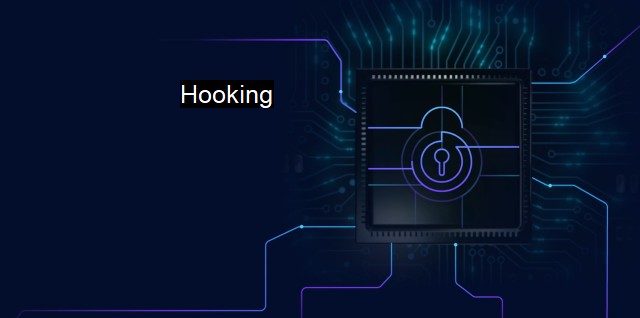What is Hooking?
The Increasing Threat of Hooking in Cybersecurity: Understanding the technique and its three types - API, System Calls, and Inline Hooking - hackers use to exploit systems and evade security measures.
Hooking refers to a range of techniques used in computer programming to enhance or alter how an operating system or a piece of software operates, often for the purpose of debugging or reverse engineering. the term takes on additional layers of meaning, often being contextually engaged with antivirus programs and malware protection. Simply put, it describes the process where an attacker intercepts system function calls, messages, or events happened on a piece of software. This interception is achieved through inserting a certain set of instructions which redirect system-level operations to a given function controlled by attackers.On an architectural level, hooking functions mainly by intercepting the software address locations. It is technically interweaving a piece of coded instruction or directive within procedures of an existing system. It involves a pointer that points to the actual implemented function and inserts itself into the sequence of events or processes inside a code structure. Once the 'hook' is in place, it enables either access to system data, modification of system functions or redirection of processes.
Even though hooking could be legally employed for benign objectives like debugging, fixing runtime errors, or customizing user interfaces, it becomes malicious in the hands of cyber attackers, hence, the requirement for robust antivirus software solutions. Cybercriminals have extensively used hooking for essentially two devious ends – stealing user information or bolstering their islands of controlled malicious software.
Firstly, attackers can use hooking interfaces to access incoming application data in plain text form, offering a backdoor into sensitive user data, encryption keys, and passwords that can be later used for fraudulent operations. They could further automate the interception process to work stealthily, accumulating information unbeknownst to the user for prolonged periods.
Secondly, malware driven through hooking often lives in memory and is tougher to undermine for typical antivirus software. This is owing to the layered obfuscation infusing a synergistic and sophisticated resilience against antivirus solutions. Coupled with the proliferation of advanced adversarial machine learning techniques and sophisticated malware variants, endemic hooking instances pose a significant challenge for cybersecurity.
Antivirus programs that endeavor to tackle hooking should ideally operate on multiple domiciliary levels. This need is fulfilled by agile solutions focusing on real-time dynamic analysis, leveraging threats intelligence and behavioral analytical modeling. These analyses are often buttressed by proactive measures like sandboxing and virtualization that further refine their malware detection and response mechanisms.
Fighting the threat of hooking allocates substantial space for dynamic, behavior-based models. Rather than a static set of rules, cybersecurity has swiftly migrated towards implementing real-time detection by leveraging AI and machine learning libraries in threat intelligence. This escalates the operational efficiency in pinpointing anomalies, thus allowing remediation measures to kick in before potential exploit executions.
Over time, hooking aversion has created an alternate niche industry, hooking detection. Here the focus shifts from merely alleviating inflicted damage to graver anticipatory posturing. Hooking detectors survey bottom-level system instances and cross-verify with established behaviors generating process abstraction layers. Sugging anomalies peeking through cleverly obfuscated code could be flagged for further investigation.
Thus, hooking in cybersecurity terms essentially exemplifies an iceberg analogy – we find much more beneath the surface level, beneath our cursory observations. Thwarting it does less involve a winner-takes-all aggressive stance, than understanding the propensity for systemic vulnerabilities, being on the defensive with robust antivirus programs while remaining proactive in our outlooks. Tackling the issue with renewed vigor and a re-imagined sense of purpose would go a long way in bolstering our collective security paraphernalia. It is indeed vital to remember that every little step taken in this direction resonates with the contour of monumental cybersecurity strides.

Hooking FAQs
What is hooking in cybersecurity?
In cybersecurity, hooking refers to a technique used by hackers to intercept and manipulate system functions or application programming interfaces (APIs).What are the different types of hooks used in cybersecurity?
There are two main types of hooks used in cybersecurity: inline hooks and API hooks. Inline hooks are injected directly into code, while API hooks are used to hijack function calls made by applications.How can antivirus software detect and prevent hooking attacks?
Antivirus software can detect hooking attacks by monitoring system behavior for suspicious activity, such as unexpected modifications to system files or application code. To prevent hooking attacks, antivirus software can use advanced techniques like code signing and behavior-based detection to identify and block malicious code.What can I do to protect my computer from hooking attacks?
To protect your computer from hooking attacks, you should keep your antivirus software up to date and regularly scan your system for malware. Additionally, you can minimize your risk of exposure by avoiding suspicious websites and emails, using strong passwords, and keeping all software and operating systems patched and updated.| | A | | | B | | | C | | | D | | | E | | | F | | | G | | | H | | | I | | | J | | | K | | | L | | | M | |
| | N | | | O | | | P | | | Q | | | R | | | S | | | T | | | U | | | V | | | W | | | X | | | Y | | | Z | |
| | 1 | | | 2 | | | 3 | | | 4 | | | 7 | | | 8 | | |||||||